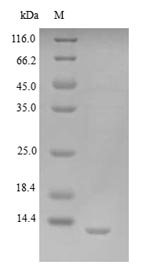Recombinant Vaccinia virus Protein K3 (VACWR034) is manufactured using a yeast expression system. The protein spans the complete sequence from amino acids 1 to 88. An N-terminal 6xHis-tag is attached, which makes purification and detection more straightforward. SDS-PAGE analysis confirms the purity exceeds 90%. This product is intended strictly for research purposes and appears to deliver consistent results across different experimental conditions.
Protein K3 from vaccinia virus seems to play a key role in how the virus manipulates host immune responses. The protein likely participates in pathways that disrupt the host's natural antiviral defenses, which is why it has become an important focus in virology and immunology studies. Learning more about how K3 functions may provide valuable insights into viral disease mechanisms and the complex interactions between pathogens and their hosts - knowledge that could prove essential for creating new treatments.
Potential Applications
Note: The applications listed below are based on what we know about this protein's biological functions, published research, and experience from experts in the field. However, we haven't fully tested all of these applications ourselves yet. We'd recommend running some preliminary tests first to make sure they work for your specific research goals.
Based on the provided information, recombinant Vaccinia virus Protein K3 (VACWR034) is produced in a yeast expression system as a full-length protein (1-88aa) with an N-terminal 6xHis-tag. Yeast expression systems provide eukaryotic folding machinery capable of supporting disulfide bond formation and some post-translational modifications, which may aid in proper folding for this viral protein. As a full-length protein, it has a reasonable probability of correct folding. However, viral proteins often have unique structural requirements that may not be fully replicated in heterologous systems, and the His-tag could potentially interfere with folding or function. Purity >90% by SDS-PAGE is determined under denaturing conditions and does not confirm native folding or bioactivity. No validation data (e.g., functional assays, circular dichroism) are provided. Therefore, while yeast expression increases the likelihood of correct folding, the protein's structural and functional integrity cannot be confirmed without experimental validation.
1. Vaccinia Virus Protein Interaction Studies
If correctly folded, the recombinant K3 protein can be used in pull-down assays to identify host cell interaction partners, as the His-tag facilitates immobilization. However, if misfolded, interaction domains may be altered, leading to non-specific binding or failure to recognize genuine biological partners, compromising the validity of viral-host interaction mechanisms studied.
2. Antibody Development and Characterization
This application is suitable as antibody generation primarily relies on linear epitope recognition, which is independent of folding status. The high purity and full-length sequence support consistent immunization and screening. However, if misfolded, antibodies may not optimally recognize conformational epitopes of the native K3 protein in biological contexts.
3. Biochemical and Biophysical Characterization
If properly folded, the protein is suitable for biophysical studies like circular dichroism or dynamic light scattering to analyze structure and stability. However, if misfolded, data would misrepresent the native protein's architecture, leading to incorrect conclusions about K3's properties.
4. ELISA Development
If correctly folded, the His-tagged K3 can be used as a coating antigen in ELISA for antibody detection. However, if misfolded, it may not present native epitopes accurately, resulting in unreliable assay results or false negatives in antibody screening.
Final Recommendation & Action Plan
This yeast-expressed full-length K3 protein may be correctly folded but requires validation before functional applications; the action plan includes: first confirming folding through biophysical methods (e.g., circular dichroism for secondary structure) and functional assays (e.g., interaction tests with known host proteins if available); if validation confirms proper folding, proceed with applications while noting potential tag interference; if misfolded, consider using alternative expression systems or tag-free protein; antibody development can proceed immediately but validate antibodies against native K3 in viral contexts; for ELISA and interaction studies, include controls like known interacting proteins or antibodies to ensure reliability. Always prioritize validation to avoid misleading results in viral protein research.






